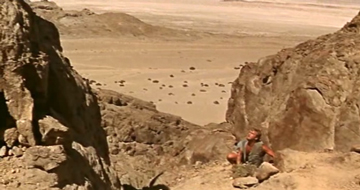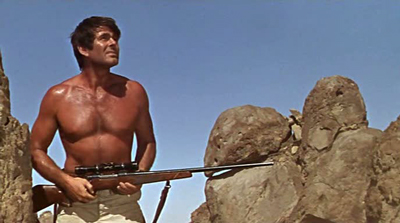
 |
|
|
|
given censorship rules. Otherwise it seems like 'Swiss Family Robinson'." -- Cy Endfield 1 
Director Cy (sometimes Cyril) Endfield was a remarkable blacklistee whose American career was taken away by the HUAC investigators just before he could establish himself as an A-list director. Endfield's last two Hollywood movies were exposé dramas highly critical of the social status quo. The Underworld Story and Try and Get Me! (The Sound of Fury) (both 1950) revealed undercurrents of bigotry, racism and lawlessness in a society dominated by the interests of the rich and powerful. Although never a member of the Communist party, Enfield had been active in leftist politics in the 1930s and knew that he would be called before the committee to 'confess' and name names. He instead left the country, joining the ranks of Joseph Losey, Jules Dassin and John Berry. Relocated to England, Enfield often directed under false names. In 1956 he worked with young actor Stanley Baker, who wanted very much to start his own production company. They would later make the enormous 70mm Road Show hit Zulu, which was filmed on an epic scale in South Africa. The partners' immediate follow-up feature took advantage of their South African experience. William Mulvehill's novel Sands of the Kalahari put a grimly realistic spin on the oft-told story of plane crash survivors lost in the wilderness. Standard plane crash epics were often emotional dramas, and the typical passenger list included honeymoon couples, criminals on the way to prison, disillusioned soldiers of fortune, etc. The classic case is John Farrow's Five Came Back (1939), which builds to a moral reckoning on who will fly to safety and who will be left behind.
Endfield and Baker's Sands of the Kalahari (1965) instead takes an unsentimental look at the boundary between civilization and savagery, a theme that would soon be revisited in more brutal African adventures like Cornel Wilde's The Naked Prey and Robert Aldrich's The Flight of the Phoenix. Endfield's screenplay sets up a nightmare of survival in which the greatest hazard comes from within the downed group of fliers -- five men and one young woman. They make an innocuous change to their itinerary, and a few hours later find themselves stranded in one of the most desolate places on Earth, with barely more than the clothes on their backs.
As if challenged by the savage baboons, O'Brien strips off his shirt and starts flexing his territorial imperative. He has his rifle and plenty of ammunition and proceeds to slay monkeys left and right, to establish dominance but also to lessen competition for the food supply. Old Grimmmelman dispenses cautious observations and the Doctor remains cheerful and cooperative. Bain stays silent, watching O'Brien and Sturdevan establish themselves as the he-men of the outfit. When O'Brien brings down an Eland, everybody feasts. As their hope for a timely rescue fades, other interests take precedent. Grace openly gravitates toward O'Brien, like an animal choosing the fittest biological partner. Sturdevant suddenly gets it in his head to rape Grace, and just as abruptly volunteers to walk out alone to bring help. In the pilot's absence O'Brien's ruthlessness comes to the fore; he decides that his chances for survival would be enhanced if there were fewer colleagues to feed. The anti-social madness of the bold individualist O'Brien links up with the unflinching pessimism of writer-director Endfield's earlier noir thrillers: Sands of the Kalahari is a good riposte to Ayn Rand's The Fountainhead. 
Cy Endfield and cinematographer Erwin Hillier give Sands of the Kalahari a beautiful, hard surface in Panavision and Technicolor. Everything about the adventure is crisply staged and graphically clear. We see the millions of locusts clogging the plane's engines, pre-empting any need for a technical explanation for the crash. Endfield had directed Ray Harryhausen's somewhat distended Mysterious Island, a much different kind of lost-aircraft adventure. Its fantastic monsters were almost the entire show. Here in the Kalahari, Endfield and his animal handlers (and special effects & makeup people) give us a truly frightening mob of baboons, each with a muzzle filled with dagger-like teeth. Although the film uses some excellent traveling mattes, there are no phony cutaways to fake docu footage or nature film. These powerful, intelligent monkeys are a constant threat. How O'Brien expects to hold them off when his cartridges run out, only he can say -- he purposely throws himself into dangerous situations, as if craving the thrill of combat. O'Brien becomes a modern Tarzan, lording it over the savage animals. To Endfield's credit none of this seems overwrought, not when Grace elects to passively let the strongest man claim her, and not when O'Brien runs barebacked through the rocks to blast away at his simian foes. (One hitch -- we'd think anybody with exposed skin would be blistering after an hour in that sun). Doctor Bondrachai is alone and unarmed when he is confronted by a wary, potentially deadly band of Bushmen. Sturdevan finds out the hard way that the plane has crashed in territory set aside for diamond mining, and that brutal company security men will assume that anyone caught within the perimeter is a poacher. In the end, Bain must face off with O'Brien, a much more experienced killer. 
As the baboons wait for an opportunity to retaliate, they provide a telling contrast to the human intruders. Their troop maintains internal unity as they raise their infants in the harsh desert environment -- none of them is disloyal to the tribe. Kalahari seems to predict more famous directors' films about the struggle for survival. O'Brien's stand-off with a group of aggressive baboons in a small outcropping of rock looks very much like the better-known "Dawn of Man" waterhole scene in Stanley Kubrick's later 2001: A Space Odyssey. And Susannah York's silent response to the desolation of the desert reminds us of Jenny Agutter in Nicolas Roeg's later Walkabout. None of the marooned travelers takes up the standard role of intrepid hero or plucky heroine. Endfield explores character detail only enough to motivate the narrative, so we must decide for ourselves why Grace behaves as she does, and why Bain remains passive for so long. O'Brien, the man of action, may be Stuart Whitman's best job of screen acting. The next year's An American Dream signaled his descent into less important roles and television work. None of the characters is a "type", not even Harry Andrews' ex-Wehrmacht officer. Theodore Bikel is especially likeable as the kind Doctor, an inoffensive fellow who is nowhere near as helpless as he appears. When MGM was involved the studio originally intended to star Elizabeth Taylor and Richard Burton. Although the famous acting couple became attached to many more projects than they actually filmed, it appears that they were indeed willing to film in the African desert under Kalahari's harsh conditions. 
Olive Films' DVD of Sands of the Kalahari is a superlative presentation. The bright picture has excellent color and contrast and no flaws to speak of, and Erwin Hillier's cinematography is so precise that we wince at a shot of the airplane flying into the sun. John Dankworth's serviceable score underlines the film's emotional highlights, including the grim finale. American advertising in 1965 emphasized the kind of "not recommended for children..." viewer warnings associated with a horror film, a gambit that proved successful with The Naked Prey as well as Cornel Wilde's Beach Red. A couple of years later, much more violent fare like Bonnie & Clyde, Point Blank and The St. Valentine's Day Massacre were enough to ensure the adoption of a ratings system, and the abandonment of the increasingly unworkable Production Code guidelines. Sands of the Kalahari is also available in a Blu-ray Edition.
On a scale of Excellent, Good, Fair, and Poor,
Sands of the Kalahari rates:
Footnote:
1. An interview with Cy Endfield, Brian Neve, Film Studies Issue 7 Winter 2005 Manchester University Press
Reviews on the Savant main site have additional credits information and are often updated and annotated with reader input and graphics. Also, don't forget the 2010 Savant Wish List. T'was Ever Thus.
Review Staff | About DVD Talk | Newsletter Subscribe | Join DVD Talk Forum |
| ||||||||||||||||||